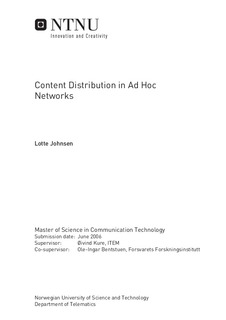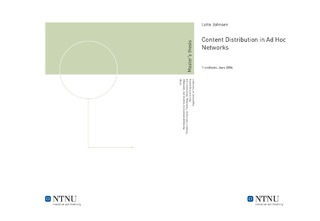| dc.description.abstract | Multicast is used to send data to many receivers simultaneously. Multicast protocols developed for wired networks are not suitable for a Mobile Ad Hoc Network (MANET), mainly because the mobile nodes create a changing topology, and the capacity of the nodes and the links are low compared to a wired network. Hence, it is a challenge to distribute information in an Ad Hoc network. A goal for this Master s thesis work has been to investigate content distribution in mobile ad hoc networks to find possible ways to reduce necessary volume of distribution data. Scaling according to available bandwidth and alternative distribution methods to multicast has been investigated. A test architecture consisting of different components useful for content distribution has been configured and tested. Essential components have been: Multicast OLSR (MOLSR); a multicast plugin for the MANET protocol Optimized Link State Routing Protocol (OLSR), to forward multicast data File Delivery over Unidirectional Transport (FLUTE); a protocol that supports sending multicast data in several layers Linux Fedora Core 5 operating system including IEEE 802.11b Wireless Local Area Network (WLAN) adapters A topology emulator to simulate different topologies The first tests were performed using three nodes. Different bit rates and packet sizes were tested to find the best throughput. After adding two more nodes to the network it became clear that the multicast forwarding did not work properly. Many of the first tests have thus given misleading results. After finding an explanation to the multicast forwarding fault, a modification to the test architecture was done; use an older version of Linux Fedora Core. The new test results then showed that it is possible to forward multicast data using FLUTE on a MANET. As expected, the nodes receive a larger amount of the file sent as the number of hops is decreased; up to 100 percent after one hop, whereas up to 80 percent after four hops. Also, test results showed that low data rates give better throughput than high rates. The best throughput was given after resending the FLUTE session several times. The performance of ad hoc networks is less trustworthy than wired / fixed networks. The amount received varies from 0 to 100 percent. The testing of layering using FLUTE did not give any improvements. However, layered content was not available, so all the channels had the same content. Suggestions to possible ways to provide layered content are described. The concept of layering is still interesting for MANETs since it provides the ability for nodes with low capacity to receive less content than nodes with high capacity in a relatively simple way. Further tests are needed to see the results using layered content. When implementations of codec frameworks become more available, these may be great for scaling in ad hoc networks. | nb_NO |

